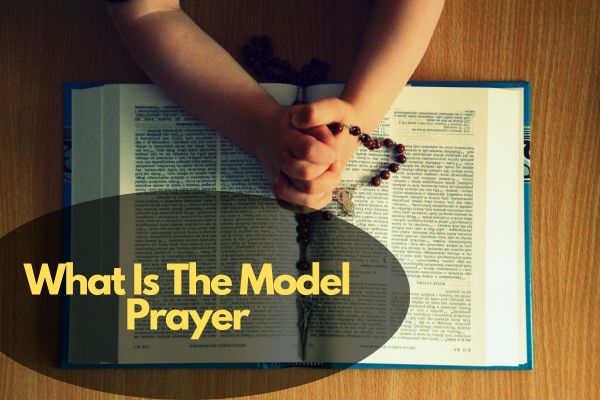Table of Contents Show
In the realm of spiritual practices and beliefs, the significance of prayer cannot be understated. Among the many prayer forms known to humankind, one that stands out for its universality and profound message is the Model Prayer. Commonly known as the Lord’s Prayer or Our Father, the Model Prayer has transcended religious boundaries and cultural contexts, leaving a lasting impact on individuals and communities worldwide.
What Is the Model Prayer
The Model Prayer, also known as the Lord’s Prayer, is a central aspect of Christian worship, and it is often recited in various Christian denominations during church services and private devotions. Its enduring appeal lies in its simplicity, yet profound and comprehensive message, guiding believers to approach God with reverence, submission, and trust while addressing their essential physical and spiritual needs. It serves as a foundation for understanding the core principles of Christian faith and the relationship between God and His children.
The Model Prayer
as taught by Jesus, serves as a timeless and universal framework for Christian prayer. It is both a source of spiritual guidance and a source of reflection on the foundational principles of faith. In English (UK) language, the prayer is typically recited as follows:
“Our Father, who art in heaven, Hallowed be thy name. Thy kingdom come, thy will be done, On earth as it is in heaven. Give us this day our daily bread, And forgive us our trespasses, As we forgive those who trespass against us. Lead us not into temptation, But deliver us from evil. Amen.”
Breaking down the Model Prayer
“Our Father, who art in heaven”
This opening address acknowledges God as a loving and divine Father who is in heaven. It establishes a personal and reverent connection between the believer and God.
“Hallowed be thy name”
This phrase emphasizes the sanctity and holiness of God’s name. It reflects a desire for God’s name to be revered and honored.
“Thy kingdom come, thy will be done, on earth as it is in heaven”
Here, believers express their desire for God’s divine rule to be established on Earth, with His will being followed as it is in heaven. This reflects the submission of human will to God’s greater plan.
“Give us this day our daily bread”
This request acknowledges human dependence on God for their daily sustenance, both physical and spiritual.
“And forgive us our trespasses, as we forgive those who trespass against us”:
Believers seek forgiveness for their sins while recognizing the need to forgive others. This highlights the Christian principle of forgiveness and reconciliation.
“Lead us not into temptation”
A plea for God to guide and protect believers from being led astray or tempted by sin.
“But deliver us from evil”
A request for God’s protection and deliverance from all forms of evil and harm.
“Amen”
The prayer concludes with “Amen,” which is an affirmation of faith and agreement with the sentiments expressed in the prayer. It is a way of saying, “So be it.”
Understanding the Origin and Significance
The origins of the Model Prayer can be traced back to the teachings of Jesus Christ, who introduced this prayer to his disciples as a model of how to pray. Its significance lies not only in its religious connotations but also in the values and principles it embodies, serving as a guide for leading a virtuous life and fostering a deeper connection with the divine.
Exploring the Structure and Verses
The Model Prayer comprises several verses, each carrying a distinct message and purpose. Analyzing its structure reveals a comprehensive framework for expressing reverence, seeking guidance, and embracing a sense of unity with the divine. Understanding the significance of each verse is crucial to comprehending the depth of its teachings.
The Meaning and Interpretation of Each Verse
Exploring the intricacies of each verse unravels layers of profound meaning and spiritual guidance. From acknowledging the holiness of the divine to seeking sustenance and forgiveness, each line of the Model Prayer encourages introspection and fosters a sense of humility and gratitude.
Historical Context of the Model Prayer
Placing the Model Prayer in its historical context provides valuable insights into the societal and cultural milieu of the time. Understanding the prevalent beliefs and practices during its inception aids in grasping the radical nature of its teachings and its revolutionary impact on contemporary religious thought.
The Global Influence of the Model Prayer
Despite its Christian origins, the Model Prayer has traversed geographical and cultural boundaries, garnering widespread recognition and reverence across diverse communities and faith traditions. Its universal message of peace, forgiveness, and divine providence has transcended religious dogmas, fostering a shared understanding of human spirituality.
Comparing the Model Prayer Across Different Religions
Beyond Christianity, the Model Prayer shares striking similarities with prayers and invocations in various other religious traditions. Drawing parallels with similar prayers in Islam, Judaism, and other faiths highlights the shared values and aspirations that bind humanity together, emphasizing the common essence of spiritual yearning and devotion.
The Model Prayer’s Relevance in Contemporary Society
Despite the passage of centuries, the Model Prayer continues to hold relevance in the contemporary world, offering solace and guidance in times of uncertainty and turmoil. Its timeless teachings resonate with individuals seeking inner peace, moral guidance, and a deeper connection with the divine, serving as a source of strength and resilience in the face of modern challenges.
Practical Applications and Impact on Personal Spiritual Growth
Applying the teachings of the Model Prayer to one’s personal spiritual journey fosters a sense of introspection and self-discovery. Embracing its principles encourages individuals to cultivate virtues such as compassion, forgiveness, and gratitude, leading to profound personal transformation and spiritual enlightenment.
Exploring Modern Interpretations and Adaptations
In light of evolving social and cultural dynamics, the Model Prayer has undergone various interpretations and adaptations, resonating with contemporary sensibilities and addressing the spiritual needs of a diverse and ever-changing global community. Exploring these modern interpretations sheds light on the dynamic nature of spiritual practices and their ability to adapt to the evolving human experience.
Addressing Common Misconceptions Surrounding the Model Prayer
Despite its widespread recognition, the Model Prayer is often subject to misinterpretations and misconceptions, leading to misunderstandings about its core teachings and intended message. Clarifying these misconceptions is essential in preserving the authenticity and integrity of its spiritual guidance, ensuring its true essence is not lost in misinterpretation.
Critiques and Debates on the Model Prayer
As with any religious or spiritual practice, the Model Prayer has not escaped scrutiny and critical analysis. Various scholars and theologians have engaged in debates surrounding its theological implications, historical accuracy, and ethical implications, contributing to a nuanced understanding of its significance and its place in contemporary religious discourse.
Analyzing the Model Prayer’s Role in Community and Fellowship
Beyond its individual significance, the Model Prayer plays a pivotal role in fostering a sense of communal harmony and fellowship among believers. Its recitation in communal gatherings and religious services serves as a unifying force, fostering a shared sense of devotion and spiritual kinship among congregants, transcending social and cultural barriers.
The Model Prayer’s Influence on Art and Literature
The profound spiritual themes and timeless values embedded within the Model Prayer have inspired artists, writers, and poets across the ages. Its influence on various forms of artistic expression, including paintings, literature, and music, reflects its enduring impact on human creativity and cultural expression, reinforcing its status as a transcendent spiritual archetype.
Conclusion
In conclusion, the Model Prayer stands as a timeless testament to the power of faith, compassion, and divine grace. Its enduring legacy continues to resonate with individuals and communities, offering a source of solace, guidance, and spiritual enlightenment in the midst of life’s myriad challenges and uncertainties. The Model Prayer remains an embodiment of the universal human quest for transcendence and spiritual fulfillment, transcending religious boundaries to touch the hearts and souls of believers and seekers worldwide.
FAQs
1. Is the Model Prayer exclusive to Christianity?
The Model Prayer originated within the context of Christian teachings but has transcended religious boundaries, resonating with individuals from various faith traditions.
2. How can one incorporate the teachings of the Model Prayer into daily life?
Embracing the virtues of humility, forgiveness, and gratitude, as emphasized in the Model Prayer, can foster personal growth and spiritual enrichment in everyday life.
3. What are some common misconceptions surrounding the Model Prayer?
Some misconceptions include misinterpretations of its intended message, its exclusivity to Christianity, and its applicability only within religious contexts.








